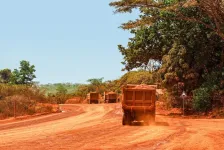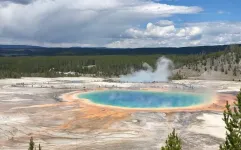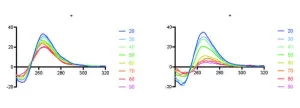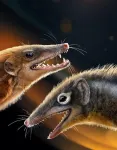(Press-News.org) A recent study led by researchers from the German Centre for Integrative Biodiversity Research (iDiv), the Martin Luther University Halle-Wittenberg (MLU) and the non-profit conservation organization Re:wild shows that the threat of mining to the great ape population in Africa has been greatly underestimated. Their results have been published in Science Advances.
The rising demand for critical minerals, such as copper, lithium, nickel, cobalt, and other rare earth elements required for the large-scale transition to cleaner energy is causing a surge of mining in Africa, where a large share of those mineral resources is still unexploited. This is driving deforestation of tropical rainforests, which are home to many species, including humans’ closest living relatives, the great apes. The study estimates that the threat of mining to great apes in Africa has been greatly underestimated and that more than one-third of the entire population - nearly 180,000 gorillas, bonobos and chimpanzees - are at risk. The researchers also highlight that because mining companies are not required to make biodiversity data publicly available, the true impact of mining on biodiversity and great apes, in particular, may be even higher.
In their study, the team used data on operational and preoperational mining sites in 17 African nations and defined 10 km buffer zones to account for direct impacts, such as habitat destruction and light and noise pollution. They also defined 50 km buffer zones for indirect impacts linked to increased human activity near mining sites: New roads and infrastructure are built to access these once-remote areas, and many people migrate to these areas looking for employment. This in turn, increases pressures on great apes and their habitat through increased hunting, habitat loss, and higher risk of disease transmission. By integrating data on the density distribution of great apes, the researchers investigated how many African apes could potentially be negatively impacted by mining and mapped areas where frequent mining and high ape densities overlapped.
Great apes in West Africa are most severely affected
In the West African countries of Liberia, Sierra Leone, Mali, and Guinea, overlaps of high ape density and mining areas – including the 10 km and 50 km buffer zones – were the largest. The most significant overlap of mining and chimpanzee density - both in terms of proportion of population and overall numbers - was found in Guinea. Here, more than 23,000 chimpanzees, or up to 83% of Guinea’s ape population, could be directly or indirectly impacted by mining activities. In general, the most sensitive areas - those with relatively high ape and mining densities - are not protected.
“Currently, studies on other species suggest that mining harms apes through pollution, habitat loss, increased hunting pressure, and disease, but this is an incomplete picture,” says first author Dr Jessica Junker, researcher at Re:wild and former postdoctoral researcher at iDiv and MLU. “The lack of data sharing by mining projects hampers our scientific understanding of its true impact on great apes and their habitat.”
The researchers also explored how mining areas intersect with what is considered 'Critical Habitat'—regions crucial for their unique biodiversity, unrelated to apes. They found a noteworthy 20% overlap between the two. Critical Habitat designation entails strict environmental regulations, especially for mining projects seeking funding from entities like the International Finance Corporation (IFC) – a branch of the World Bank which lends funds to the private sector – or other lenders adhering to similar standards, and aiming to operate within these zones. Previous efforts to map ‘Critical Habitat’ in Africa have overlooked significant portions of ape habitats that would qualify under international benchmarks such as the IFC Performance Standard 6. “Companies operating in these areas should have adequate mitigation and compensation schemes in place to minimize their impact, which seems unlikely, given that most companies lack robust species baseline data that are required to inform these actions,” says Dr Tenekwetche Sop, manager of the IUCN SSC A.P.E.S. Database at the Senckenberg Museum of Natural History, a repository of all great ape population data. “Encouraging these companies to share their invaluable ape survey data with our database serves as a pivotal step towards transparency in their operations. Only through such collaborative efforts can we comprehensively gauge the true extent of mining activities' effects on great apes and their habitats.”
Short-term offset plans fail to compensate for the long-term impacts of mining
Even though the indirect and long-term impacts of mining are difficult to quantify, they often extend well beyond the boundaries of the actual mining project. Currently, these risks are rarely considered and mitigated by mining companies. Compensation or offset is then based on an approximation of impacts, which the researchers suggest is often inaccurate, and underestimated. Furthermore, current offset schemes are developed to last as long as mining projects are active (usually c.20 years), whereas most mining impacts on great apes are permanent.
”Mining companies need to focus on avoiding their impacts on great apes as much as possible and use offsetting as a last resort as there is currently no example of a great ape offset that has been successful”, explains Dr Genevieve Campbell, lead of the IUCN SSC PSG SGA/SSA ARRC Task Force and senior researcher at Re:wild. ‘’Avoidance needs to take place already during the exploration phase, but unfortunately, this phase is poorly regulated and ‘baseline data’ are collected by companies after many years of exploration and habitat destruction have taken place. These data then do not accurately reflect the original state of the great ape populations in the area before mining impacts.’’
“A shift away from fossil fuels is good for the climate but must be done in a way that does not jeopardize biodiversity. In its current iteration it may even be going against the very environmental goals we’re aiming for”, says Jessica Junker. “Companies, lenders and nations need to recognize that it may sometimes be of greater value to leave some regions untouched to mitigate climate change and help prevent future epidemics.”
END
Demand for critical minerals puts African Great Apes at risk
More than a third of Africa’s great ape population faces risks related to mining
2024-04-03
ELSE PRESS RELEASES FROM THIS DATE:
Tourism to Yellowstone National Park produces more than a billion kilos of CO2 emissions annually
2024-04-03
Tourism to Yellowstone National Park produces more than a billion kilos of CO2 emissions annually, with 90% arising through travel to and from the park, especially from visitors arriving by plane.
####
Article URL: https://journals.plos.org/climate/article?id=10.1371/journal.pclm.0000391
Article Title: Quantifying and evaluating strategies to decrease carbon dioxide emissions generated from tourism to Yellowstone National Park
Author Countries: United States
Funding: This work was supported by the Utah Agricultural Experiment Station (Project ...
Air quality in schools: Shielding kids with intellectual and developmental disabilities from COVID
2024-04-03
During the pandemic, University of Rochester Medical Center (URMC) researchers, including those from the Intellectual and Developmental Disabilities Research Center (IDDRC), teamed up with the Mary Cariola Center to study ways to prevent COVID infection among children with intellectual and developmental disabilities (IDD), a particularly vulnerable population. Together, they found that good airflow and filtration in schools may help these children and their teachers avoid COVID infections.
The COVID pandemic was a particularly difficult balancing act for children with IDDs and their ...
JAX researchers make mice a more powerful tool to study a wide range of human diseases
2024-04-03
In humans, the exact same mutation in a specific gene can produce widely different outcomes. It’s a bit like adding the same amount of salt to different recipes—the effect on the finished dish can be quite different, depending on the mix of other ingredients. Now, researchers at The Jackson Laboratory (JAX) have developed a powerful platform to study the reasons behind these varying mutation outcomes. The work, published today in Science Advances, not only provides new opportunities for uncovering targets for therapeutic interventions but also represents a significant step forward in addressing the critical need ...
Immunotherapy for Alzheimer’s disease shows promise in mouse study
2024-04-03
Alzheimer’s disease starts with a sticky protein called amyloid beta that builds up into plaques in the brain, setting off a chain of events that results in brain atrophy and cognitive decline. The new generation of Alzheimer’s drugs — the first proven to change the course of the disease — work by tagging amyloid for clearance by the brain’s immune cells.
Now, researchers at Washington University School of Medicine in St. Louis have found a different and promising way to remove the noxious plaques: by directly mobilizing immune cells to consume ...
Study gives first view of centromere variation and evolution
2024-04-03
A genomic study of human and selected nonhuman primate centromeres has revealed their unimaginable diversity and speed of evolutionary change.
In cell genetics, a centromere is the spot where two sister chromatids attach. A chromatid is one-half of a duplicated chromosome. United pairs of chromosomes have identifiable shapes because centromeres are not in a uniform position. As a cell prepares to divide, the machinery to separate and segregate chromosomes goes into action at each centromere location.
Unless the genetic material ...
New tools reveal how genes work and cells organize
2024-04-03
Proteins binding to RNA are important in many processes in the cell and can mediate a range of biological functions. A specialized structure in both DNA and RNA, the G-quadruplex, are regulatory elements involved in gene expression in both DNA and RNA. In the present work the researchers use theoretical predictions and molecular biology experiments to show that many chromatin-binding proteins bind to RNA G-quadruplexes. With this information they can classify proteins based on their potential to bind RNA G-quadruplexes.
The study uses a combination of experimental identification of RNA G-quadruplex-binding proteins and computational methods to build a prediction tool that identify the probability ...
New study shows LLMs respond differently based on user’s motivation
2024-04-03
A new study recently published in the Journal of the American Medical Informatics Association (JAMIA) reveals how large language models (LLMs) respond to different motivational states. In their evaluation of three LLM-based generative conversational agents (GAs)—ChatGPT, Google Bard, and Llama 2, PhD student Michelle Bak and Assistant Professor Jessie Chin of the School of Information Sciences at the University of Illinois Urbana-Champaign found that while GAs are able to identify users' ...
Top multiple sclerosis neurologists & scientists to headline CMSC Annual Meeting for healthcare professionals
2024-04-03
The leading research and educational conference for multiple sclerosis healthcare professionals in North America, the Consortium of Multiple Sclerosis Centers (CMSC) 38th Annual Meeting, returns to Nashville, Tennessee, May 29-June 1, 2024 at the Music City Center. The conference is renowned for its emphasis on reaching the interprofessional team involved in MS care, with learning opportunities for physicians, advanced practice clinicians, nursing professionals, pharmacists, mental health and rehabilitation specialists, dietitians, researchers, advocates and other members of the healthcare team involved in the management of people with MS.
...
Novel fabrication technique takes transition metal telluride nanosheets from lab to mass production
2024-04-03
Transition metal telluride nanosheets have shown enormous promise for fundamental research and other applications across a rainbow of different fields, but until now, mass fabrication has been impossible, leaving the material as something of a laboratory curiosity rather than an industrial reality. But a team of researchers has recently developed a novel fabrication technique—the use of chemical solutions to peel off thin layers from their parent compounds, creating atomically thin sheets—that looks set to finally deliver on the ultra-thin substance's promise.
The researchers describe their fabrication technique in a study published in Nature on April 3.
In ...
Two Jurassic mammaliaforms from China shed light on mammalian evolution
2024-04-03
Mammaliaforms are extinct and extant organisms that are closely related to mammals. Studying mammaliaforms helps scientists understand the evolutionary processes that led to various mammalian features.
In two consecutive studies in Nature, Dr. MAO Fangyuan and Dr. ZHANG Chi from the Institute of Vertebrate Paleontology and Paleoanthropology (IVPP) of the Chinese Academy of Sciences, together with colleagues from Australia and the United States, recently reported two Jurassic mammaliaforms from China, revealing the earliest dental diversification, mandibular middle ears, and articular-quadrate joint transformation of mammaliaforms.
The ...
LAST 30 PRESS RELEASES:
New expert guidance urges caution before surgery for patients with treatment-resistant constipation
Solar hydrogen can now be produced efficiently without the scarce metal platinum
Sleeping in on weekends may help boost teens’ mental health
Study: Teens use cellphones for an hour a day at school
After more than two years of war, Palestinian children are hungry, denied education and “like the living dead”
The untold story of life with Prader-Willi syndrome - according to the siblings who live it
How the parasite that ‘gave up sex’ found more hosts – and why its victory won’t last
When is it time to jump? The boiling frog problem of AI use in physics education
Twitter data reveals partisan divide in understanding why pollen season's getting worse
AI is quick but risky for updating old software
Revolutionizing biosecurity: new multi-omics framework to transform invasive species management
From ancient herb to modern medicine: new review unveils the multi-targeted healing potential of Borago officinalis
Building a global scientific community: Biological Diversity Journal announces dual recruitment of Editorial Board and Youth Editorial Board members
Microbes that break down antibiotics help protect ecosystems under drug pollution
Smart biochar that remembers pollutants offers a new way to clean water and recycle biomass
Rice genes matter more than domestication in shaping plant microbiomes
Ticking time bomb: Some farmers report as many as 70 tick encounters over a 6-month period
Turning garden and crop waste into plastics
Scientists discover ‘platypus galaxies’ in the early universe
Seeing thyroid cancer in a new light: when AI meets label-free imaging in the operating room
Neutrophil-to-lymphocyte ratio may aid risk stratification in depressive disorder
2026 Seismological Society of America Annual Meeting
AI-powered ECG analysis offers promising path for early detection of chronic obstructive pulmonary disease, says Mount Sinai researchers
GIMM uncovers flaws in lab-grown heart cells and paves the way for improved treatments
Cracking the evolutionary code of sleep
Medications could help the aging brain cope with surgery, memory impairment
Back pain linked to worse sleep years later in men over 65, according to study
CDC urges ‘shared decision-making’ on some childhood vaccines; many unclear about what that means
New research finds that an ‘equal treatment’ approach to economic opportunity advertising can backfire
Researchers create shape-shifting, self-navigating microparticles
[Press-News.org] Demand for critical minerals puts African Great Apes at riskMore than a third of Africa’s great ape population faces risks related to mining







